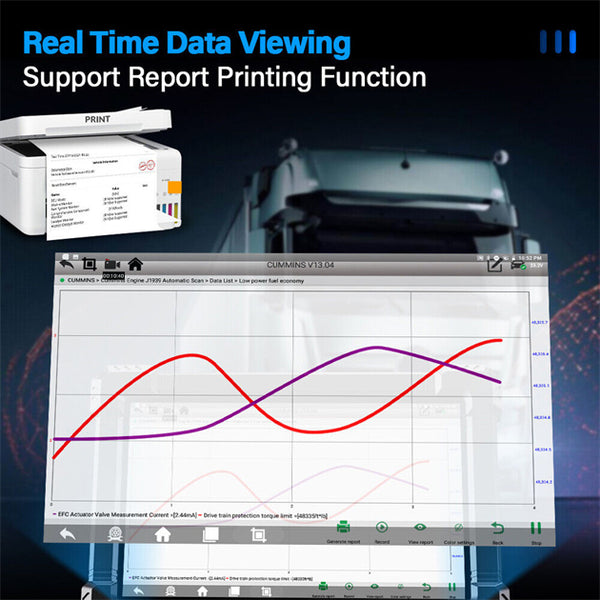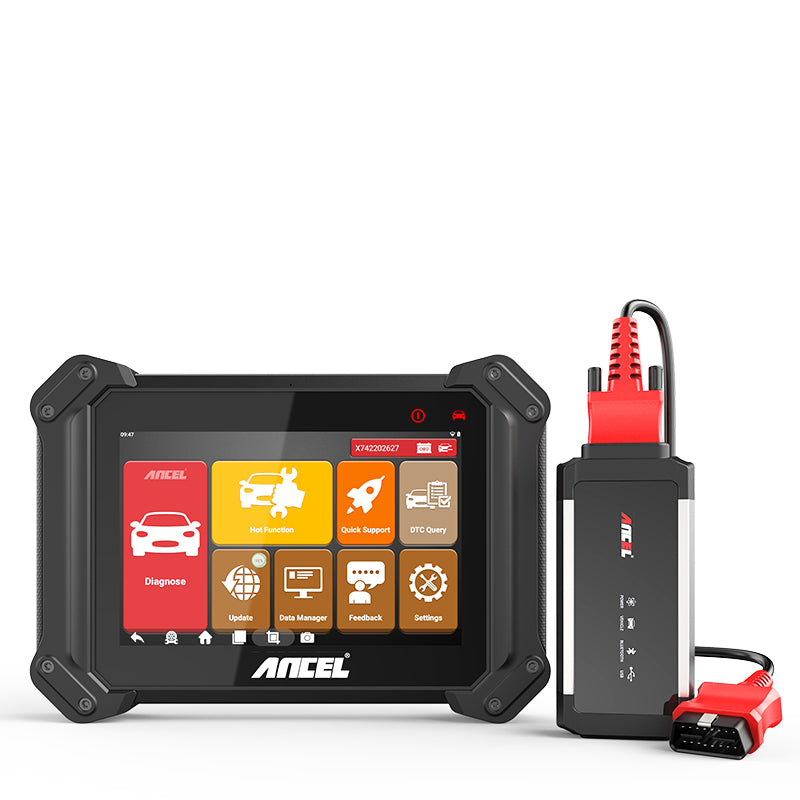Have you ever marveled at how quickly a mechanic can figure out what's wrong with your car?
These tools allow mechanics to pull crucial data that leads to accurate diagnoses.
Engine diagnostics involve using specialized tools to read and interpret data from a vehicle's onboard computer.
These tools can identify problems within the engine, transmission, exhaust system, and other critical components.
OBD2 Scanner
The car scanner tool stands at the forefront of vehicle diagnostics.
Since 1996, regulations have required vehicles to be equipped with an OBD2 system, making these scanners crucial for modern automotive care.
By connecting to a car's OBD2 port, typically located beneath the dashboard, the scanner for cars serves as a bridge to the vehicle's onboard computer, unlocking a wealth of data about the car's performance and health.

How OBD2 Scanners Work
Accessing Data: Once plugged into the OBD2 port, the obd2 scanner with bluetooth communicates with the vehicle's computer to access a variety of operational data and diagnostic trouble codes (DTCs).
Interpreting Codes: These DTCs are alphanumeric codes that the vehicle's computer generates when it detects anomalies.
Each code points to a specific issue, such as problems with the emission control system, engine performance, or even transmission temperature irregularities.
-
P0420 – Catalyst System Efficiency Below Threshold (Emission Control System)
-
P0300 – Random/Multiple Cylinder Misfire Detected (Engine Performance)
-
P0171 – System Too Lean (Bank 1) (Fuel and Air Mixture)
-
P0301 to P0308 – Cylinder Misfire (Engine Performance)
-
P0130 – Oxygen Sensor Circuit Malfunction (Bank 1, Sensor 1) (Emission Control)
-
P0500 – Vehicle Speed Sensor Malfunction (Transmission or Speed Control)
-
P0700 – Transmission Control System Malfunction (Transmission Issues)
-
P0440 – Evaporative Emission Control System Malfunction (Fuel System)
-
P0128 – Coolant Thermostat (Coolant Temperature Below Thermostat Regulating Temperature)
-
P0113 – Intake Air Temperature Sensor 1 Circuit High Input (Engine Performance)
Troubleshooting: The scanner not only identifies the codes but, in many cases, also provides descriptions or definitions for each, guiding the user toward understanding the nature and severity of the problem.
Real-Time Monitoring: Best car diagnostic scanner tool can monitor real-time data from the vehicle's sensors, offering live insights into engine temperature, fuel efficiency, and more, further aiding in diagnostics and performance optimization.
The Significance of OBD2 Scanners
Emissions Control: One of the primary functions of the OBD2 system is monitoring emissions.
By ensuring vehicles meet emission standards, OBD2 scanners play a direct role in environmental conservation efforts.
Maintenance and Repair: These scanners significantly streamline the troubleshooting process, allowing for more accurate and faster repairs. This efficiency not only saves time but also reduces the costs associated with diagnostics and repair work.
Vehicle Health: Regular use of best code reader for cars can help detect potential issues before they escalate into serious problems, promoting longer vehicle lifespan and improved performance.
Related Reading: Ancel X7HD - The Best Truck Scanner in Diagnostic Industry
Code Readers vs. Scan Tools: What's the Difference?
Code readers and scan tools are both critical components of automotive diagnostics, yet they serve different purposes and offer varying levels of functionality.
Code Readers: The Basics
Code readers are the simpler of the two tools.
Their primary function is to read and clear diagnostic trouble codes (DTCs) from the vehicle's onboard computer.
These devices are typically straightforward to use, making them accessible even to those with minimal automotive knowledge.
-
Read and Clear Codes:
They can identify the codes associated with the illumination of the check engine light, for instance.
-
Basic Information:
Code readers may provide a brief description or definition of the trouble codes.
-
Affordability:
Due to their limited functionality, code readers are generally less expensive than scan tools.
Code readers are suitable for individuals looking to perform basic diagnostic tasks, such as finding out why a check engine light is on and resetting it once the issue is resolved.
Scan Tools: Advanced Diagnostics
Scan tools are more sophisticated and provide a comprehensive suite of diagnostic functions.
They cater to those who require deeper insights into their vehicle's performance and issues.
-
Real-Time Data Monitoring: Scan tools can display live data from various sensors and systems within the vehicle, allowing for detailed monitoring of its performance.
-
System Tests: They can perform active tests on various systems, such as the fuel pump, ABS, and more, to check their functionality.
-
Advanced Diagnostics: Beyond just reading and clearing codes, scan tools can provide detailed information on the cause of a problem, potential fixes, and more.
- Software Updates: Many scan tools come with the option for software updates, expanding their compatibility and functionality to cover newer vehicle models and technologies.
Scan tools are ideal for professionals or enthusiasts who need to perform detailed diagnostics, understand real-time vehicle data, and execute specific system tests.
The choice between a code reader and a scan tool largely depends on your needs:
- If you're simply looking to diagnose why a warning light is on and possibly reset it, a code reader might suffice.
- For more in-depth diagnostics, real time performance monitoring, and the ability to perform active tests on vehicle systems, a scan tool is the better choice.
Other Tools Utilized
Here are the tools other professional auto mechanics use:
Advanced Diagnostic Tools for Specific Issues
For more complex problems, mechanics may use advanced diagnostic tools. These include devices designed to test specific components like the fuel injector, battery, and alternator.
They provide a deeper insight into the vehicle's intricate systems, helping pinpoint the exact source of an issue.
Digital Multimeters and Oscilloscopes
Digital multimeters measure electrical values with high precision, while oscilloscopes display the electrical signal, allowing mechanics to see how it changes over time.
These tools are crucial for diagnosing issues in the vehicle's electrical system.
Fuel Pressure Gauges and Vacuum Testers
These tools assess the health of a vehicle's fuel system.
Fuel pressure gauges measure the pressure in the fuel rail, which is vital for the engine's performance, and vacuum testers check for leaks in the vacuum system, which can cause engine performance issues.
Compression Testers
Compression testers measure the pressure in the engine's cylinders, which is critical for powerful combustion.
Low compression can indicate serious issues like a damaged head gasket or worn piston rings, which can lead to major engine problems.
$439.99
The Role of Software in Engine Diagnostics
As vehicles evolve, becoming more complex and integrated with advanced technologies, the software that powers diagnostic tools has become crucial in interpreting the vast amounts of data these vehicles produce.
Constant Updates for Compatibility
Vehicles are continually updated with new features, systems, and technologies.
Diagnostic software keeps pace through regular updates, ensuring compatibility with the latest vehicle models.
This includes expanding the database of diagnostic trouble codes (DTCs) and ensuring that the tool can accurately communicate with new vehicle systems.
Without these updates, diagnostic tools might miss or misinterpret data from newer models, leading to inaccurate diagnostics.
Enhanced Diagnostic Techniques
Advanced software algorithms can analyze data more effectively, identifying potential issues that might not be apparent through traditional diagnostics.
This includes predictive diagnostics, where software can forecast potential system failures before they happen, based on subtle patterns or anomalies in the vehicle's data.
Such capabilities are invaluable in preventive maintenance, helping to avoid breakdowns and costly repairs.
Integration with Repair Databases
Many diagnostic software packages are integrated with extensive databases of repair information, including step-by-step repair guides, wiring diagrams, and component locations.
This integration provides mechanics with not just the diagnostic data but also the knowledge needed to address the issues, all within the same tool.
Such comprehensive resources significantly streamline the repair process, enhancing efficiency and accuracy.
Tips for Using Diagnostic Tools Effectively
Effectively utilizing diagnostic tools is essential for accurate vehicle analysis and repair.
Understand Vehicle Specifics
Know the Make and Model: Different vehicles may have unique systems and codes.
Familiarize yourself with the specific make and model you're working on to better interpret diagnostic data.
Consult the Manufacturer's Guidelines: Manufacturers often provide specific diagnostic procedures.
Regularly Update Diagnostic Software
Stay Current: Ensure that the software in your diagnostic tools is up-to-date to include the latest vehicle models, codes, and diagnostic techniques.
Subscribe to Updates: Many tool manufacturers offer subscription services for updates. These can be invaluable for keeping your tools effective against newer vehicle technologies.
Accurate Data Interpretation
Understand the Codes: Simply reading codes isn’t enough. Invest time in understanding what each code means in the context of the vehicle's operation.
Look Beyond the Codes: Use real-time data and system tests available in your tools to get a comprehensive view of the vehicle’s condition.
Document Your Findings
Keep Records: Document the diagnostic codes, the steps taken, and the results of those actions. This can be valuable for future diagnostics on the same vehicle or for similar issues in different vehicles.
Invest in Quality Tools
Choose Reputable Brands: Opt for diagnostic tools from reputable manufacturers known for accuracy, reliability, and support. Quality tools are an investment in your diagnostic capabilities. Check ANCEL car scan tool!
Where to Buy Tools Used by Professional Auto Mechanics
If you're looking to equip yourself with the same high-quality tools used by professional auto mechanics, look no further than ANCEL’s official website.
Renowned for their reliability and effectiveness, ANCEL’s auto repair tools have garnered widespread acclaim from professionals in the field.
Catering to a diverse range of budgets and requirements, whether you seek specific functionality or need comprehensive system diagnostics, ANCEL’s varied product lines are designed to meet your unique needs.
With ANCEL, you can rest assured that you’re getting industry-standard equipment, whether you're a seasoned mechanic or an enthusiastic DIYer aiming for professional-grade results in your auto repair projects.
Conclusion
Engine diagnostic tools are the backbone of modern automotive repair.
From the essential OBD-II scanner to more specialized equipment like compression testers and digital multimeters, these tools enable mechanics to diagnose and fix our vehicles with precision and efficiency.
As vehicles become increasingly complex, the role of these diagnostic tools will only grow.
FAQs
Can I use these diagnostic tools at home?
Yes, basic tools like code readers are user-friendly and can be used at home to diagnose common issues. However, for more complex diagnostics and repairs, professional assistance is recommended.
How often should my vehicle undergo diagnostic testing?
It's wise to have your vehicle checked if you notice any unusual signs (like strange noises or warning lights on the dashboard) or as part of regular maintenance. An annual diagnostic check can also help catch potential issues early.
Are engine diagnostic tools expensive?
The cost varies widely depending on the tool's complexity. Basic code readers are quite affordable, while professional-grade scan tools and other specialized equipment can be more expensive.
Recommended Similar Articles:
- OBD2 Scanner with Bluetooth Is Essential for Modern Drivers
- How a BMW Scan Tool Can Transform Your Car Maintenance Routine
- The Ultimate Guide to Using a Car Diagnostic Scanner
- Cutting Costs with Heavy Duty Truck Scanner | A Case Study
- How to Spot Car Trouble Before it Happens with Your BMW OBD2 Scanner
















1 thought on “What Engine Diagnostic Tools Do Mechanics Use?”
joseph agius
we’re can i buy ancel scanner in australia